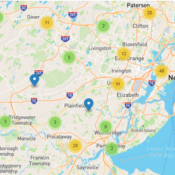Interactive: NJ’s Estimated Weekly U-6 Unemployment Rate
The Impact of COVID-19 on New Jersey’s Workforce
NJ’s Estimated Weekly U-6 Unemployment Rate
Prior to COVID-19, Focus NJ was tracking the state’s employment rate on a monthly basis, given that the state was experiencing historic lows in unemployment. However, the novel coronavirus is having a major impact on New Jersey’s workforce, dramatically increasing the number of unemployment insurance weekly claims and the state’s total unemployed population.
The Bureau of Labor Statistics publishes several measures of work force underutilization. The official measure of unemployment is the U-3 rate, which is the total number of unemployed as a portion of the total civilian labor force.[1] Unemployed are those who do not have a job, have actively sought employment in the last 4 weeks, and are available to work. Those temporarily laid off and waiting to be brought back to a job are also considered unemployed. The civilian labor force is the number of unemployed, plus the number of employed individuals.[2]
Another measure of unemployment is the U-6 rate, which is the unemployed, plus those marginally attached to the labor force, plus total employed part time for economic reasons, as a portion of the civilian labor force, plus all persons marginally attached to the labor force.[3] A worker is marginally attached if they want to work and can do so, has looked for a job in the last 12 months, but has not looked for a job in the last 4 weeks. Being part time due to economic reasons means an individual works part-time hours because they are unable to get full-time hours. [4]
The U-6 rate captures a great deal of those uncounted by the U-3 measure and, therefore, more accurately depicts the strain in labor markets caused by COVID-19. Specifically, many individuals have stopped looking or are unable to work due to non-essential business closures. These workers are marginally attached and counted by the U-6 measure. Others have become part-time workers since nearly all businesses have experienced declines in economic activity. These workers are also included in the U-6 measure as part time due to economic reasons.
*The Estimated Weekly U-6 Unemployment Rate is an estimate based off Feb. 2020 Civilian Labor Force data.
References:
[1] “Table A-15. Alternative measure of labor underutilization,” U.S. Bureau of Labor Statistics, May 11, 2020, https://www.bls.gov/news.release/empsit.t15.htm
[2] “Labor Force Characteristics,” U.S. Bureau of Labor Statistics, May 5, 2020, https://www.bls.gov/cps/lfcharacteristics.htm#fullpart
[3] “Table A-15. Alternative measure of labor underutilization,” U.S. Bureau of Labor Statistics, May 11, 2020, https://www.bls.gov/news.release/empsit.t15.htm
[4] “Labor Force Characteristics,” U.S. Bureau of Labor Statistics, May 5, 2020, https://www.bls.gov/cps/lfcharacteristics.htm#fullpart
Interactive Sources:
US Bureau of Labor Statistics. New York-New Jersey Information Office.
US Bureau of Labor Statistics. Unemployment Insurance Weekly Claims.




